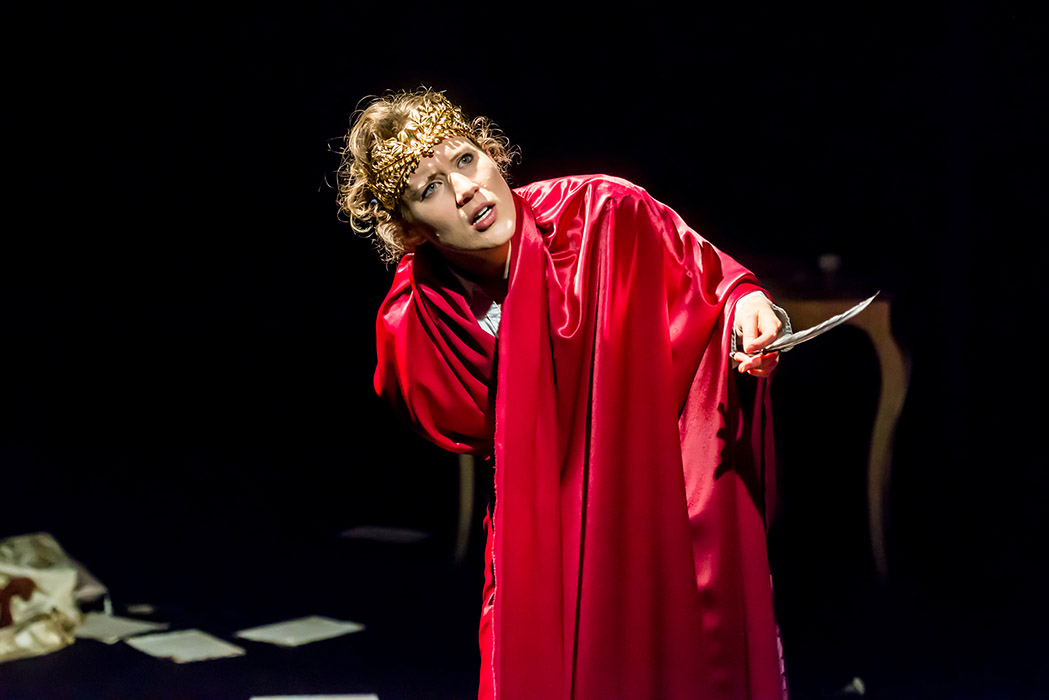The often curious intersection of art and history was discovered in South Knoxville last evening, as Marble City Opera offered its latest—a production created and performed by soprano Sarah Toth—Nero Monologues. The work, currently being staged in a marble-tiled space at the historic Candoro Marble building, falls into the category of pastiche: a creation consisting of both original and borrowed musical and dramatic elements. In this case, Toth’s work combines original music by Peter Learn with arias from Handel and Monteverdi, and with spoken word drawn from Nero’s Poems by the Australian poet Geoffrey Lehmann. Learn’s very enticing original and adapted music is scored for a string quartet and piano.
A revealing of the tortured psyche of the Emperor Nero in his final hours, Nero Monologues does make a presumption of at least a passing knowledge of 1st Century Roman history from audience members. While one can easily take in the work on an abstract level of music and theatre, it becomes compelling theatre only when one is aware of a few key facts of Nero’s life: he regarded himself as an artist; he loved to sing in musical entertainments and take female roles; and he loved to wrestle, paint, and sculpt. In contrast to the image of the universal man he wished to cultivate, he was also said to enjoy cruelty, brutality, and perversity. His reign was marked by deceit and tyrannical repression that were products of paranoia, guilt, and fear of real or imagined political enemies.
Should we attach contemporary significance to Toth’s theatrical allusions in Nero Monologues? Directed by Marya Barry, this production has Toth joined at times by three mute “souls” (Barry, Kayla Beard, and Emily Simmons) who act as extensions—or facilitators—of that tortured psyche. With the space encircled by mirrors reflecting the action back onto the audience, theatrical symbols—knives, drawings, and elements of suggestive clothing—quickly become elements of drama. Clad in black trousers with suspenders and a white shirt, Toth transforms this starkness into color with Lehmann’s text and the progressive array of suggestive props. A daybed covered in a blood red cloth fills the center of the room of black and white marble tiles, making a bold visual statement. The psychological content of the work, though, seemed to cry out for a bit more in the way of substantial theatrical atmosphere, i.e. dramatic lighting, to punctuate the moments of startling reveal and pantomimed violence.
Contemporary reflections notwithstanding, I found the most notable and admirable features of the evening were soprano Toth herself and the instrumental ensemble. As a vocalist, Toth possesses a marvelous instrument of remarkable clarity and power that provided a solid foundation for the dramatic abstractions of unease and anxiety. Although her fortissimo outbursts spoke for themselves in the small room, her ability to produce a gorgeous lyrical solidity at pianissimo levels—and in close quarters to the audience—was truly impressive. In the early Baroque material, her delivery was beautifully crisp and lyrical.
Also impressive was the ensemble, consisting of the Inner Voices String Quartet and pianist Danny Brian. Situated in an adjacent room, the musicians seemed to have solved whatever synchronization issues there may have been and concentrated on a smooth, yet firm and cohesive performance of the intriguing score. The Inner Voices String Quartet consists of violinists Ruth Bacon and Sarah Ringer, violist Christy Graffeo, and cellist Jeanine Wilkinson.
There are two more performances of MCO’s Nero Monologues: Friday (11/2) and Sunday (11/4) evenings at 7:30 PM. Tickets.








